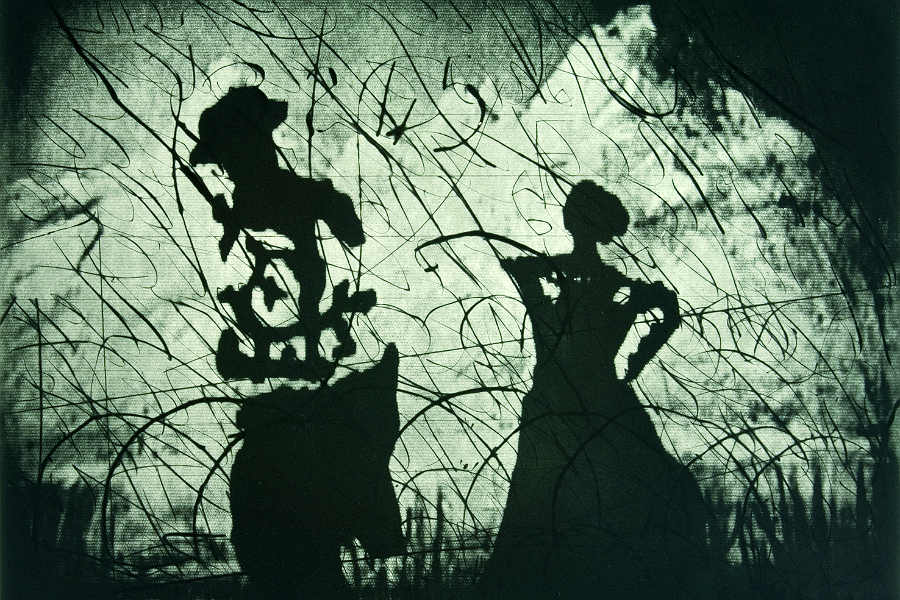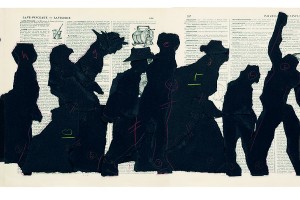A Universal Archive: William Kentridge as Printmaker

A new William Kentridge exhibition, with print at its core, is a resounding delight at the Bluecoat…
How to follow John Akomfrah’s Unfinished Conversation? Quite justifiably one of the most widely praised and written about artworks in Liverpool Biennial 2012. Coming in the wake of Akomfrah’s film, which presented so eloquently how difference manifests itself and is dealt with in society, was always going to be a big ask. But that was the task faced by the Bluecoat and its exhibitions curator, Sara-Jayne Parsons.
In the event, incredibly, nobody need have been concerned. Either a wonderful piece of serendipitous synchronicity or foresight (most likely the former given how at least another three exhibitions opened elsewhere in Liverpool on the same night) meant that A Universal Archive: William Kentridge as Printmaker, came to the Bluecoat hot on the heels of the South African’s work also featuring prominently in Tate Liverpool’s current Tracing the Century exhibition.
A trio of his animations take pride of place at the end of an exhaustive exhibition of drawing on Tate’s fourth floor (which we’d urge you to also go and see), and they serve marvelously to whet the appetite for this major exhibition, which features around 100 pieces ranging from the relatively small and intimate, to vast, imposing works, covering a range of media and techniques.
If, like us, your first experience of Kentridge happened to be with those three films at Tate (Main Complaint, Felix in Exile and Mine) – which amount to no less than a succinct and powerful allegory of South Africa’s political upheaval – you could be forgiven for perceiving him to be predominantly a political artist. Indeed, he freely admits: “all of my work is about Johannesburg in one form or another.”
A Universal Archive nonetheless illustrates, as with Mandela, that it was possible – if highly dangerous – to escape from under the shadow of that regime, both in an expressive and very real sense. That’s not to say that apartheid and wider South African observations don’t encroach into his work and this exhibition, because they clearly do, more that they are aspects of life as he saw it.
So, you have overtly subversive pieces such as Art in a State of Hope and Art in a State of Siege –Kentridge saw these “as acts of political opposition”, and Portage (2000, pictured), a four metres long print evoking displaced apartheid-era migrant workers, and the plight of refugees worldwide. But, AUA is a depiction of the things (for better and/or worse) that inspire Kentridge: a day-to-day life lived, experienced and captured with wit, anger, exuberance and everything in-between. If this exhibition makes anything clear, it’s that his resistance to the title of ‘Political Artist’ is wholly fair.
 Rather than be tethered to a particular area, AUA highlights that, though Kentridge clearly incorporated recurrent themes, he displays nothing if not a vast range of influences: the series of etchings entitled Nose he made during the development of ideas for the production of the Shostakovich opera (The Nose) he would direct indicate his admiration of Constructivism, the exceptionally reserved use of colour (just a little red and a little blue make their way into the gallery spaces here) and an almost pathological reverence to technology of a bygone age: Monitor, The Full Stop, A Universal Archive and Unremember depict different makes and models of typewriters.
Rather than be tethered to a particular area, AUA highlights that, though Kentridge clearly incorporated recurrent themes, he displays nothing if not a vast range of influences: the series of etchings entitled Nose he made during the development of ideas for the production of the Shostakovich opera (The Nose) he would direct indicate his admiration of Constructivism, the exceptionally reserved use of colour (just a little red and a little blue make their way into the gallery spaces here) and an almost pathological reverence to technology of a bygone age: Monitor, The Full Stop, A Universal Archive and Unremember depict different makes and models of typewriters.
Perhaps – aside from the aforementioned variety of inspiration – what strikes most is the skill, imagination and pure draftsmanship inherent in his work. Zeno II – a collection of seven prints made by projecting found images onto a wall, then photographing the projections and transferring them onto photogravure plates, before finally reworking them with drypoint, thus achieving a beguiling photo-realist look – reflects both the man’s ingenuity and ability with stunning results.
Zeno II, with its depictions of bi-planes locked in air-to-air combat, smoke trailing in their wake, and silhouetted soldiers with bayonets at the ready, while relatively muted in scale compared to some of the work in this show, make for such a beautiful testament to Kentridge, his resourcefulness and skill, thus rendering them a personal highlight (admittedly amongst many other candidates) of this exhibition which so successfully presents an artist expressing all of society as he sees it.
A Universal Archive – William Kentridge as Printmaker 10am – 6pm continues @ the Bluecoat until Sunday the 3rd February
Portage (2000)/Zeno II (2003) images ©the artist and David Krut Fine Art, New York and Johannesburg, Unremember (2012) Courtesy the artist, Photo: John Hodgkiss, ©the artist





